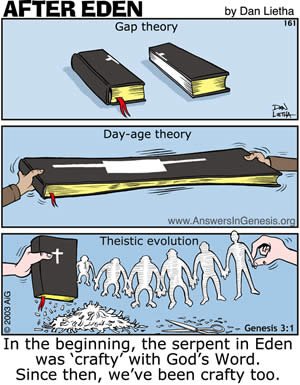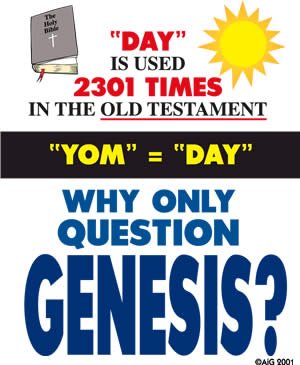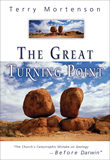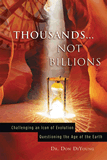
Chapter 2
Why Shouldn’t Christians Accept Millions of Years?
Is the age of the earth unimportant and divisive, as some Christians claim? Answers in Genesis thinks not.
Dr. Terry Mortenson answers the question, “Why Shouldn’t Christians Accept Millions of Years?” as featured in The New Answers DVD 1.
There is an intensifying controversy in the church all over the world regarding the age of the earth. For the first 18 centuries of church history, the almost universal belief of Christians was that God created the world in six literal days roughly 4,000 years before Christ and destroyed the world with a global Flood at the time of Noah.
But about 200 years ago some scientists developed new theories of earth history, which proposed that the earth and universe are millions of years old. Over the past 200 years Christian leaders have made various attempts to fit the millions of years into the Bible. These include the day-age view, gap theory, local flood view, framework hypothesis, theistic evolution, and progressive creation.

A growing number of Christians (now called young-earth creationists), including many scientists, hold to the traditional view, believing it to be the only view that is truly faithful to Scripture and that fits the scientific evidence far better than the reigning old-earth evolutionary theory.
Many Christians say that the age of the earth is an unimportant and divisive side issue that hinders the proclamation of the gospel. But is that really the case? Answers in Genesis and many other creationist organizations think not.
In this chapter, I want to introduce you to some of the reasons we think that Christians cannot accept the millions of years without doing great damage to the church and her witness in the world. Other chapters in this book will go into much more detail on these issues.
- The Bible clearly teaches that God created in six literal, 24-hour days a few thousand years ago. The Hebrew word for day in Genesis 1 is yom. In the vast majority of its uses in the Old Testament it means a literal day; and where it doesn’t, the context makes this clear.
- The context of Genesis 1 clearly shows that the days of creation were literal days. First, yom is defined the first time it is used in the Bible (Genesis 1:4–5) in its two literal senses: the light portion of the light/dark cycle and the whole light/dark cycle. Second, yom is used with “evening” and “morning.” Everywhere these two words are used in the Old Testament, either together or separately and with or without yom in the context, they always mean a literal evening or morning of a literal day. Third, yom is modified with a number: one day, second day, third day, etc., which everywhere else in the Old Testament indicates literal days. Fourth, yom is defined literally in Genesis 1:14 in relation to the heavenly bodies.
- The genealogies of Genesis 5 and 11 make it clear that the creation days happened only about 6,000 years ago. It is transparent from the genealogies of Genesis 5 and 11 (which give very detailed chronological information, unlike the clearly abbreviated genealogy in Matthew 1 and other chronological information in the Bible that the Creation Week took place only about 6,000 years ago.
-
Exodus 20:9–11 blocks all attempts to fit
millions of years into Genesis 1. “Six days
you shall labor and do all your work, but the
seventh day is a sabbath of the LORD your
God; in it you shall not do any work, you or
your son or your daughter, your male or your
female servant or your cattle or your sojourner
who stays with you. For in six days the LORD
made the heavens and the earth, the sea and all
that is in them, and rested on the seventh day;
therefore the LORD blessed the sabbath day
and made it holy” (Exodus 20:9-11).
This passage gives the reason for God’s command to Israel to work six days and then take a sabbath rest. Yom is used in both parts of the commandment. If God meant that the Jews were to work six days because He created over six long periods of time, He could have said that using one of three indefinite Hebrew time words. He chose the only word that means a literal day, and the Jews understood it literally (until the idea of millions of years developed in the early nineteenth century). For this reason, the day-age view or framework hypothesis must be rejected. The gap theory or any other attempt to put millions of years before the six days are also false because God says that in six days He made the heaven and the earth and the sea and all that is in them. So He made everything in those six literal days and nothing before the first day.
- Noah’s Flood washes away millions of years. The evidence in Genesis 6–9 for a global catastrophic flood is overwhelming. For example, the Flood was intended to destroy not only all sinful people but also all land animals and birds and the surface of the earth, which only a global flood could accomplish. The Ark’s purpose was to save two of every kind of land animal and bird (and seven of some) to repopulate the earth after the Flood. The Ark was totally unnecessary if the Flood was only local. People, animals, and birds could have migrated out of the flood zone before it occurred, or the zone could have been populated from creatures outside the area after the Flood. The catastrophic nature of the Flood is seen in the nonstop rain for at least 40 days, which would have produced massive erosion, mud slides, hurricanes, etc. The Hebrew words translated “the fountains of the great deep burst open” (Genesis 7:11) clearly point to tectonic rupturing of the earth’s surface in many places for 150 days, resulting in volcanoes, earthquakes, and tsunamis. Noah’s Flood would produce exactly the kind of complex geological record we see worldwide today: thousands of feet of sediments clearly deposited by water and later hardened into rock and containing billions of fossils. If the year-long Flood is responsible for most of the rock layers and fossils, then those rocks and fossils cannot represent the history of the earth over millions of years, as evolutionists claim.
- Jesus was a young-earth creationist. Jesus consistently treated the miracle accounts of the Old Testament as straightforward, truthful, historical accounts (e.g., creation of Adam, Noah and the Flood, Lot and his wife in Sodom, Moses and the manna, and Jonah in the fish). He continually affirmed the authority of Scripture over men’s ideas and traditions (Matthew 15:1–9). In Mark 10:6 we have the clearest (but not the only) statement showing that Jesus was a young-earth creationist. He teaches that Adam and Eve were made at the “beginning of creation,” not billions of years after the beginning, as would be the case if the universe were really billions of years old. So, if Jesus was a young-earth creationist, then how can His faithful followers have any other view?
- Belief in millions of years undermines the Bible’s teaching on death and on the character of God. Genesis 1 says six times that God called the creation “good,” and when He finished creation on Day 6, He called everything “very good.” Man and animals and birds were originally vegetarian (Gen. 1:29–30, plants are not “living creatures,” as people and animals are, according to Scripture). But Adam and Eve sinned, resulting in the judgment of God on the whole creation. Instantly Adam and Eve died spiritually, and after God’s curse they began to die physically. The serpent and Eve were changed physically and the ground itself was cursed (Genesis 3:14–19). The whole creation now groans in bondage to corruption, waiting for the final redemption of Christians (Romans 8:19–25) when we will see the restoration of all things (Acts 3:21, Colossians 1:20) to a state similar to the pre-Fall world, when there will be no more carnivorous behavior (Isaiah11:6–9) and no disease, suffering, or death (Revelation 21:3–5) because there will be no more Curse (Revelation 22:3). To accept millions of years of animal death before the creation and Fall of man contradicts and destroys the Bible’s teaching on death and the full redemptive work of Christ. It also makes God into a bumbling, cruel creator who uses (or can’t prevent) disease, natural disasters, and extinctions to mar His creative work, without any moral cause, but still calls it all “very good.”
- The idea of millions of years did not come from the scientific facts. This idea of long ages was developed by deistic and atheistic geologists in the late eighteenth and early nineteenth centuries. These men used antibiblical philosophical and religious assumptions to interpret the geological observations in a way that plainly contradicted the biblical account of creation, the Flood, and the age of the earth. Most church leaders and scholars quickly compromised using the gap theory, day-age view, local flood view, etc. to try to fit “deep time” into the Bible. But they did not understand the geological arguments, and they did not defend their views by careful Bible study. The “deep time” idea flows out of naturalistic assumptions, not scientific observations.
- Radiometric dating methods do not prove millions of years. radiometric dating was not developed until the early twentieth century, by which time virtually the whole world had already accepted the millions of years. For many years creation scientists have cited numerous examples in the published scientific literature of these dating methods clearly giving erroneous dates (e.g., a date of millions of years for lava flows that occurred in the past few hundred years or even decades). In recent years creationists in the RATE project have done experimental, theoretical, and field research to uncover more such evidence (e.g., diamonds and coal, which the evolutionists say are millions of years old, were dated by carbon-14 to be only thousands of years old) and to show that decay rates were orders of magnitude faster in the past, which shrinks the millions of years to thousands of years, confirming the Bible.1


Conclusion
What is at stake here is the authority of Scripture, the character of God, the doctrine of death, and the very foundation of the gospel.
These are just some of the reasons why we believe that the Bible is giving us the true history of the world. God’s Word must be the final authority on all matters about which it speaks—not just the moral and spiritual matters, but also its teachings that bear on history, archaeology, and science.
What is at stake here is the authority of Scripture, the character of God, the doctrine of death, and the very foundation of the gospel. If the early chapters of Genesis are not true literal history, then faith in the rest of the Bible is undermined, including its teaching about salvation and morality. I urge you to carefully read the other chapters in this book. The health of the church, the effectiveness of her mission to a lost world, and the glory of God are at stake.
The New Answers Book 1
The New Answers Book 1 is packed with biblical answers to over 25 of the most important questions on creation,evolution, and the Bible.
Read Online Buy BookFootnotes
- For the results of the RATE project, see Larry Vardiman, Andrew Snelling, and Eugene Chaffin, eds., Radioisotopes and the Age of the Earth, Vol. 2, Master Books, Green Forest, Arkansas, 2005; and Don DeYoung, Thousands . . . Not Billions, Master Books, Green Forest, Arkansas, 2005.
Recommended Resources

Answers in Genesis is an apologetics ministry, dedicated to helping Christians defend their faith and proclaim the good news of Jesus Christ.
- Customer Service 800.778.3390
- Available Monday–Friday | 9 AM–5 PM ET
- © 2025 Answers in Genesis







